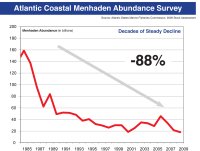Little fish, big problem
Will the menhaden population be saved?
Date published: 8/11/2011
“THE MOST IMPORTANT fish in the sea,” according to author H. Bruce Franklin, is not a whale, a tuna, a dolphin, or a shark. Instead, it’s an oily fleshed, foot-long silver fish variously called a mossbunker, pogy, or, as we know it, menhaden.
On Aug. 2, the menhaden fishery was Topic A of the Atlantic States Marine Fisheries Commission–delegates from 15 states from Maine to Florida devoted to keeping fisheries viable. The menhaden population is falling, which troubles environmentalists, naturalists, and the ASMFC.
The decline can be seen in the number of immature menhaden–those a year old or younger. In 1960, experts put the number of these small fry at about 90 billion; 25 years ago, 70 billion; last year, 18 billion. What happened? It depends on whom you ask.
Most menhaden are caught by large commercial fishing vessels owned by one company: Omega Protein out of the Northern Neck community of Reedville. Omega uses spotter planes to find schools of the little fish both in the Chesapeake Bay and the Atlantic, and huge purse seine nets to haul them aboard ship. When harvested, menhaden are ground into fish meal for use in animal feed, or they’re processed into the fish oil that people take to protect their hearts. Omega captured 160,000 metric tons of menhaden last year, 80 percent of the total fishery catch.
Company spokesman Ben Landry blames “poor water quality” for the decline in the fishery, reports The Washington Post, not overfishing. But concerns about the dropping menhaden population have caused every Atlantic Coast state–except Virginia–to greatly restrict or ban Omega’s big boats.
Regulation of the fishery in the Old Dominion lies, tellingly, with the General Assembly, not the Virginia Marine Resources Commission. Omega is heavily invested in Virginia politics: It donated $25,000 to the McDonnell Inaugural Committee in 2010 and an equal sum to the Opportunity Virginia PAC, a GOP group, according to the Virginia Public Access Project.
But the fishery is too important to be regulated by politicians. For it’s not just people who need menhaden: The little fish are a prime source of food for bigger fish such as tuna, mackerel, rockfish, bluefish, and swordfish, and for fish-eating birds such as eagles and loons. Furthermore, menhaden are consumers of phytoplankton, an overabundance of which contributes to dead zones in the Bay. This year, scientists are watching the largest-ever dead zone develop. It’s over 83 miles long and stretches from Baltimore to Virginia.
The ASMFC seems set to propose a drop in the number of menhaden permitted for harvesting. Whatever it decides should be science-based. Allowing the menhaden fishery to decline irreparably is stewardship at its worst.



When will ASMFC instructions be announced for the September-November public comment period? If not announced soon, less than the three full months will be available to the public.
Thank you for keeping us all informed regarding this important issue.